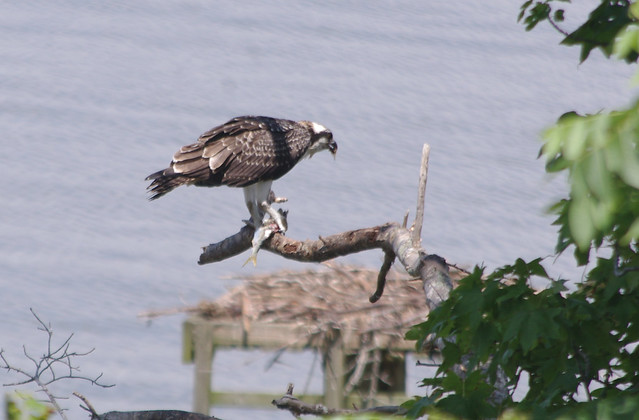Open fires are prohibited throughout the park from midnight to 4 p.m. through April 30 per the 4 p.m. Burning Law. This includes wood and charcoal. Gas is permissible. Campground fires are allowed during the restricted time if a camp host is on duty and signage to that effect is posted in the campground. Failure to observe the 4 p.m. Burning Law can result in a fine. Contact the Park Office for additional information.
Read Our Blogs
Osprey & Prey Season
One of the familiar sounds of spring in the Chesapeake Bay region is the piercing call of the osprey. This bird is well renowned for its fishing prowess. However, they are not looking for just anything that is swimming. Their main targets are herring and shad.
Osprey vs. Shad
These fish are anadromous, spending much of their adult lives in the ocean and returning to tidal fresh waters to spawn. Humans and predatory birds love American and hickory shad and blueback herring because they are rich in fatty acids and have large egg sacks called roe. No doubt, that the rich nutrients of these fish help osprey lay healthy eggs and hatch strong chicks.
Hickory Shad
Bald eagles are also attentive to the return of the fish and their winged rivals. Osprey are built for diving in the water and have a 70% accuracy rate in catching prey. Eagles habitually steal food from other birds and kill osprey chicks. However, osprey parents defend their nest very well and catch what they need to feed their young.
Unfortunately, herring and shad have been victims of habitat loss, overharvesting, and pollution. However, we humans can still enjoy these fish. Anglers are welcome to fight shad with a rod & reel on a catch and release basis. A good seafood department will have them fresh in season. Keep in mind that they are quite bony. Eat them with care, bake them at a low temperature until the bones dissolve, or try your hand at filleting them boneless.
No eating in the nest
Osprey usually arrive in the first two weeks of March at York River State Park and other places in the region. The nesting platform at the bottom of the bluff behind the Visitor Center is more active than the one along Taskinas Creek. They rarely eat inside of the nest. So, look in the pine branches near the amphitheater and gazebo. Chances are a brown and white bird is feeding on a flat bodied fish. Osprey & prey season is here.
Directions to York River State Park: From I-64, take the Croaker Exit 231B. Go north on Route 607 (Croaker Rd.) for one mile, then right on Route 606 (Riverview Rd.) about one and a half miles to the park entrance. Take a left turn into the park.
If you have read the article and have a question, please email nancy.heltman@dcr.virginia.gov.
Search for blogs
By Park
Categories
Cabins
Camping
Fishing
History and Culture
Other
Programs and Events
Trails
Volunteers
Water Fun
Archive
2024
2023
2022
2021
2020
2019
2018
2017
2016
2015
2014
2012

















